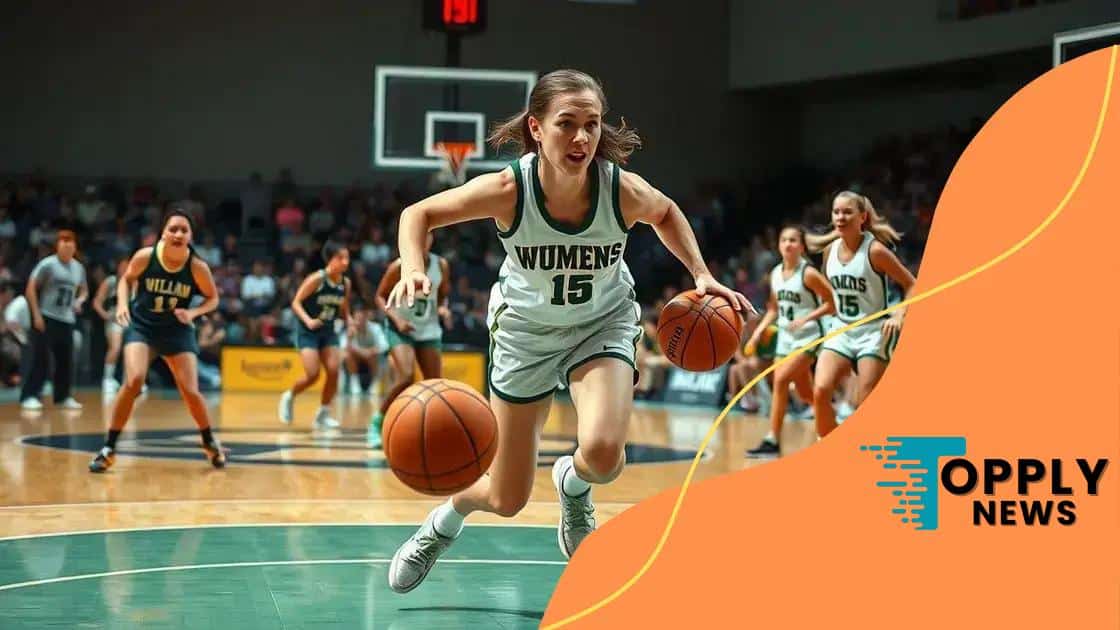Sue Bird USA Basketball director: What’s next for the team?

Sue Bird plays a pivotal role in shaping the future of USA basketball by focusing on enhancing youth programs, promoting diversity, and fostering strong leadership to develop young talent.
Sue Bird USA Basketball director is not just a title; it represents a new chapter in American basketball. Have you ever wondered how her experience shapes the future of the sport? In this article, we’ll dive into her vision and the exciting changes that are on the horizon.
Sue Bird’s impact on USA basketball
Sue Bird’s influence on USA basketball is profound and multi-faceted. As a player, she has set standards of excellence and leadership that have inspired many. Her recent role as the director offers new opportunities to shape the future of women’s basketball.
One significant area of her impact relates to talent development. Bird believes in the importance of nurturing young athletes to help them realize their potential. This includes providing training programs and mentorship that focus not just on skills but also on personal growth.
Key Contributions to USA Basketball
Bird’s contributions have been pivotal in several ways:
- Promoting inclusivity and diversity within the sport.
- Encouraging teamwork and collaboration among players.
- Enhancing visibility for women’s basketball on national and international stages.
Moreover, Bird is passionate about using her platform to advocate for important issues, such as gender equality in sports. She aims to empower the next generation, ensuring they have the resources they need to succeed. By sharing her experiences, she connects with young athletes and motivates them to strive for greatness.
The mentoring programs initiated under Bird’s guidance are tailored to equip young players with the skills necessary to thrive in competitive environments. These efforts not only help with athletic performance but also build confidence and resilience.
Bird’s leadership style emphasizes the importance of connection. She fosters a sense of community among players, allowing them to collaborate effectively. This bond strengthens teamwork and creates a positive environment for all involved in USA basketball.
In addition, Bird has pushed for advancements in training techniques and strategies. By integrating technology and analytics into training, she aims to enhance athlete performance. This forward-thinking approach is essential for keeping USA basketball at the forefront of the global stage.
Clearly, Sue Bird is not just a player; she is a visionary leader shaping the landscape of women’s basketball. Her ongoing commitment to fostering talent and innovation speaks volumes about her dedication to the sport.
Key strategies for developing young talent
Developing young talent in sports is essential for building a strong foundation for future success. With effective strategies, coaches and organizations can create an environment where young athletes can flourish. Understanding these strategies is crucial to nurturing the next generation of players.
Focus on Individual Skill Development
One key strategy involves prioritizing individual skill development. Coaches should tailor training sessions to meet the specific needs of each athlete. This personalized approach helps athletes improve their strengths while addressing any weaknesses they may have.
- Conduct regular skill assessments to identify areas for improvement.
- Incorporate drills that focus on basic techniques and advanced skills.
- Provide constructive feedback regularly to foster growth.
Another important aspect is creating a growth mindset among young players. Encouraging them to embrace challenges and learn from failures will boost their confidence. It’s essential to remind athletes that improvement takes time and effort, and setbacks are a natural part of the process.
Encourage Teamwork and Collaboration
Teamwork is a critical component in sports. By focusing on team dynamics, coaches can promote cooperation and communication among players. This not only enhances performance but also builds lasting relationships.
- Implement group drills that require players to work together.
- Organize team-building activities off the court to strengthen bonds.
- Encourage open communication during practice and games to solve problems collaboratively.
Moreover, providing mentorship opportunities can significantly impact a young athlete’s development. Pairing experienced players with younger talent allows for knowledge sharing and guidance. This connection helps younger athletes feel supported and motivated to improve.
By creating a positive and inclusive environment, coaches cultivate a love for the game among young athletes. Celebrating small victories fosters a sense of achievement and encourages players to continue striving for excellence. The excitement and passion for the sport will drive them to work harder and reach their full potential.
The evolution of women’s basketball under Bird

The evolution of women’s basketball has been significantly shaped by influential figures like Sue Bird. Her career spans decades, during which she has not only excelled as a player but also played a vital role in promoting the sport globally. Understanding this evolution helps us appreciate the strides made in women’s athletics.
The Growth of the Game
Over the years, women’s basketball has seen tremendous growth. In the past, there were fewer opportunities for female athletes, but recent years have brought a surge of interest and participation. Sue Bird, with her impressive skills and leadership, has been a central figure in this growth.
- Increased media coverage has raised awareness of women’s sports.
- The establishment of professional leagues has opened doors for aspiring athletes.
- Success in international competitions has showcased the talent of female players.
Bird’s presence on the court inspired many young girls to pursue basketball. She became a role model, showing that hard work and dedication lead to success. Her journey also emphasizes the importance of nurturing talent from a young age, paving the way for future generations.
Impact on Professional Leagues
As a key player in the WNBA, Bird has contributed to the league’s legitimacy and growth. She has helped raise the profile of women’s basketball, promoting parity and respect within the sports community. With her support, the WNBA has become a competitive platform where women can showcase their skills and strive for excellence.
Bird’s influence extends beyond playing. She has actively engaged in discussions regarding pay equity and visibility for female athletes. By advocating for these issues, she helps ensure that women receive the recognition they deserve both on and off the court. This impact encourages young athletes to pursue their dreams, knowing they have the potential to succeed.
Throughout her career, Bird has celebrated significant milestones in women’s basketball. From winning championships to being named an All-Star, she shows how dedication can affect change. Each accomplishment not only elevates her status but also uplifts the entire sport.
As women’s basketball continues to evolve, the groundwork laid by players like Sue Bird will be essential. Her legacy serves as a foundation for the future of the sport, inspiring new talent to reach for greatness.
Insights into team dynamics and leadership
Understanding team dynamics and leadership is crucial in any sport, including basketball. Effective teamwork can make the difference between winning and losing games. Leaders on the court, like coaches and veteran players, play a vital role in shaping the group’s performance.
Building Trust Among Team Members
One important aspect of team dynamics is trust. When players trust one another, they communicate better and work more effectively. This trust builds a strong foundation, allowing players to take risks and make plays without hesitation.
- Encourage open communication during practice and games.
- Arrange team-building activities to strengthen relationships.
- Recognize and celebrate individual contributions to boost morale.
Effective leaders are essential for fostering this trust. Leadership involves setting an example, motivating teammates, and providing guidance when needed. A strong leader helps to ensure that all players feel valued and included, which is vital for team cohesion.
Encouraging Collaboration and Cooperation
Collaboration is another key element of successful teamwork. Players need to learn how to work together to achieve common goals. By sharing knowledge and skills, they can elevate their overall performance. Coaches can facilitate this cooperation through specific strategies and drills that promote teamwork.
Establishing clear roles within the team also enhances collaboration. By defining each player’s responsibilities, everyone knows what is expected of them. This clarity reduces confusion and helps the team function smoothly.
Furthermore, leadership is not just about telling players what to do; it’s also about listening. A good leader encourages input from all team members. This inclusive approach fosters a sense of ownership, where players feel accountable for both their own performance and the success of the team.
As the team grows together, they develop a shared identity and purpose. This unity drives them to support one another, both on and off the court. Understanding this dynamic helps teams to adapt and respond effectively to challenges they may face during their season.
Looking ahead: Future goals for USA basketball
Looking ahead, USA basketball is focused on setting clear future goals to enhance the development of the sport. With the rise of global competition, it is vital to keep pushing the boundaries of excellence in women’s basketball. These goals aim to elevate the performance and visibility of the game.
Enhancing Youth Programs
A key goal is to strengthen youth basketball programs. By providing better resources and training for young athletes, USA basketball can cultivate talent from an early age. This involves:
- Increased funding for grassroots initiatives.
- Development of training camps and clinics to teach essential skills.
- Creating collaboration with schools to promote basketball as a vital part of physical education.
These efforts will help in nurturing the next generation of players who will represent the USA on international stages.
Expanding Diversity and Inclusion
Another goal is to expand diversity and inclusion within the sport. USA basketball aims to ensure that everyone, regardless of their background, has access to participate in basketball. This focus includes:
- Implementing programs that reach underserved communities.
- Promoting female coaches and mentors to inspire young girls.
- Creating policies that emphasize equal opportunities for all players.
By fostering inclusion, the sport will grow in popularity and talent, reflecting the diverse fabric of the nation.
Additionally, USA basketball is committed to enhancing its international presence. Competing at an even higher level in world championships can solidify America’s dominance in women’s basketball. This means investing in stronger training regimens and developing strategies to outmaneuver opponents globally.
To achieve these future goals, collaboration with various stakeholders, including schools, local clubs, and organizations, is paramount. USA basketball recognizes that working together will amplify their reach and impact, allowing them to inspire athletes across the country.
FAQ – Frequently Asked Questions about USA Basketball and Its Future Goals
What are the future goals for USA basketball?
USA basketball aims to enhance youth programs, promote diversity, and strengthen overall training initiatives.
How does USA basketball plan to promote diversity?
The organization is focusing on creating access for underserved communities and encouraging participation from all backgrounds.
Why is leadership important in developing young talent?
Strong leadership, exemplified by figures like Sue Bird, inspires young players and fosters a positive team environment.
What role does collaboration play in achieving these goals?
Collaboration with schools, clubs, and communities is essential for reaching a wider audience and promoting basketball effectively.





